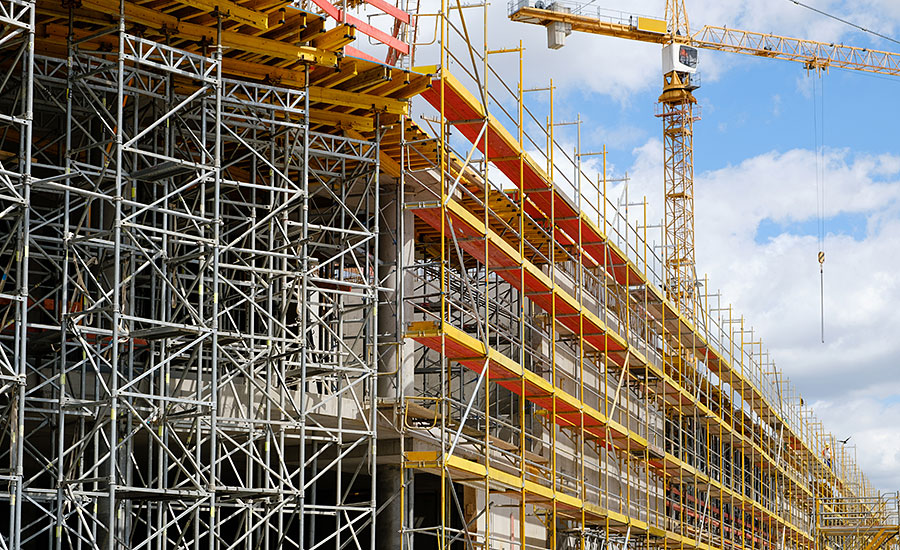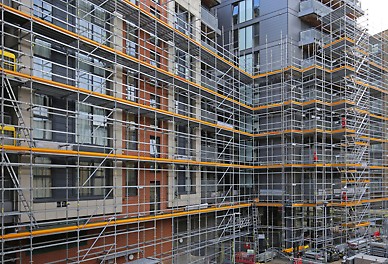Dependable Domestic Scaffolding for Homeowners in Need of Safe Renovations
Dependable Domestic Scaffolding for Homeowners in Need of Safe Renovations
Blog Article
Exploring the Numerous Kinds Of Scaffolding Made Use Of in Building And Construction Tasks
The building and construction sector depends greatly on numerous sorts of scaffolding to meet details project needs, each offering unique advantages and applications. Traditional frame scaffolding provides a sturdy structure for basic jobs, while put on hold scaffolding is crucial for service skyscraper structures. Other options, such as system and rolling scaffolding, accommodate effectiveness and movement, respectively. Moreover, the cantilever alternative verifies important in urban settings where area is constrained. Comprehending the nuances of these scaffolding kinds is important for optimizing safety and security and performance on construction sites, prompting a better examination of their one-of-a-kind qualities and applications.

Traditional Frame Scaffolding
Conventional framework scaffolding is among the most commonly used techniques in the building market due to its robustness and convenience. This system consists of straight and upright frameworks that are put together to produce a stable platform for employees and products. The main components consist of upright articles, horizontal ledgers, and angled dental braces, which together provide a strong framework that can support considerable tons.
One of the essential benefits of typical frame scaffolding is its adaptability to numerous building tasks, ranging from residential structures to large industrial frameworks. The modular design permits very easy assembly and disassembly, making it reliable for both short-term and lasting tasks. Furthermore, the system can be tailored in height and size, suiting different structure layouts and site conditions.
Safety and security is critical in scaffolding applications, and typical frame systems are furnished with guardrails and toe boards to avoid falls and make sure employee protection. Moreover, normal inspections and adherence to security guidelines are crucial in preserving the stability of the scaffold. In general, standard framework scaffolding continues to be a basic choice in the construction industry, offering a reputable system for labor and boosting total job performance

Suspended Scaffolding
Suspended scaffolding uses a special remedy for building tasks that require access to elevated surfaces, specifically in circumstances where conventional framework scaffolding might be unwise. This sort of scaffolding is generally put on hold from the roofing or upper degrees of a structure, utilizing a system of systems, ropes, and pulleys to develop a working room that can be changed to numerous heights.
Among the primary benefits of suspended scaffolding is its adaptability. It can be quickly repositioned or decreased to fit adjustments in building demands, making it optimal for jobs such as window installment, frontage job, and maintenance on skyscraper structures. Furthermore, the marginal footprint of suspended scaffolding enables better use ground room in urban atmospheres, where room is typically minimal.
Safety is an essential consideration in the usage of put on hold scaffolding. Proper rigging and anchoring systems need to be utilized to ensure stability and avoid mishaps. Operators needs to likewise be learnt the secure use this equipment. On the whole, suspended scaffolding offers a effective and efficient option for accessing hard-to-reach locations in numerous construction scenarios, improving both efficiency and safety and security on site.
System Scaffolding
System scaffolding, typically related to as a contemporary option in the scaffolding market, includes pre-engineered components that can be quickly assembled and adapted for numerous building and construction tasks. Scaffolding. This kind of scaffolding is defined by its modular layout, which permits adaptability and effectiveness on task sites, suiting architectural needs and different heights
Commonly made from high-strength steel or light weight aluminum, system scaffolding uses boosted durability and stability. The elements include vertical blog posts, straight ledgers, and angled braces, which adjoin safely, guaranteeing a durable structure. The design often includes standardized installations, simplifying setting up and disassembly processes, thereby lowering labor time and expenses.

Rolling Scaffolding
Moving scaffolding is a functional choice to traditional fixed scaffolding, designed for mobility and ease of use on construction sites. This kind of scaffolding includes a system sustained by structures with wheels, permitting employees to easily transfer it as required. The mobility feature dramatically improves productivity, as it minimizes downtime connected with assembling and dismantling repaired scaffolding.
Normally built from light-weight materials such as aluminum or steel, rolling scaffolding uses a sturdy yet mobile option for jobs requiring frequent repositioning - Scaffolding. It is specifically helpful in tasks such as paint, drywall installment, and electrical job, where accessibility to various elevations and places is required
Safety and security is extremely important in rolling scaffolding style, with features such as securing wheels to avoid unintentional activity when being used, and guardrails to protect employees from falls. In addition, lots of models are flexible in height, suiting various task requirements.
Cantilever Scaffolding

The layout of cantilever scaffolding generally involves using arms or brackets anchored to a structure or framework, making it possible for the system to expand external securely. Security is critical; therefore, these scaffolds should be engineered to withstand various tons and environmental conditions. Regular inspection and maintenance are necessary to make certain architectural stability and worker safety.
Cantilever scaffolding is preferred for its adaptability and effective use of room, making it a preferred option in urban environments where room restrictions prevail. It helps with easier accessibility to high elevations, inevitably contributing to the total effectiveness of construction jobs. As with all scaffolding kinds, proper training and adherence to safety and security requirements are critical for employees using cantilever scaffolding.
Verdict
Finally, the varied kinds of scaffolding made use of in building jobs each serve distinct objectives customized to certain website requirements. Standard structure scaffolding offers stability, while put on hold scaffolding offers convenience for elevated tasks. System scaffolding promotes quick setting up, and rolling scaffolding boosts movement for differing job atmospheres. Cantilever scaffolding properly addresses challenges in city settings. Comprehending these scaffolding kinds is essential for enhancing safety and security and performance in construction, eventually adding to the effective conclusion of projects.
Traditional frame scaffolding provides a durable foundation for general tasks, while suspended scaffolding is important for work on high-rise structures.Moving scaffolding is a functional choice to traditional set scaffolding, made for flexibility and convenience of usage on building and construction websites. As with all scaffolding types, appropriate training and adherence to safety standards are important for workers utilizing cantilever scaffolding.
Typical structure scaffolding supplies security, while put on hold scaffolding provides adaptability for raised tasks. System scaffolding helps with quick assembly, and rolling scaffolding boosts wheelchair for differing work environments.
Report this page